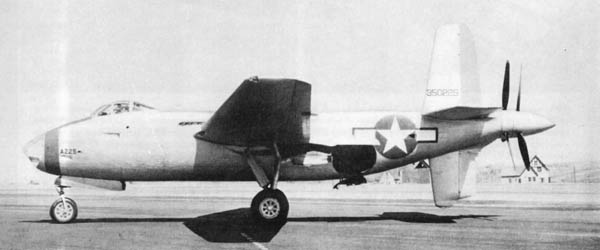A report on the Douglas XB-42 Mixmaster experimental high-speed bomber from the Air Force magazine Impact, Vol. III, No. 8, Office of the Assistant Chief of Air Staff, Intelligence, Washington, D.C., August 1945.
EXPERIMENTAL BOMBER
XB-42 is First in 400-Mile-per-Hour ClassAlthough there is no present requirement for the plane pictured here, its approach to the basic problems of bombardment is so unusual that it is felt that IMPACT readers will be interested in hearing about it.
Nose view reveals XB-42 as our sleekest bomber, with no turrets or engine nacelles to interrupt streamlining.
The traditional American bomber, the B-17 or B-24, is a large, relatively slow plane capable of carrying a moderate tonnage a long distance. It is less efficient as a freight car than its British counterpart, but it is more heavily armed and armored. This means a loss of range or load, also of speed because added turrets, etc., do not improve streamlining. The B-29, the B-32 and yet-unborn monsters like the B-36 are basically like the B-17. They are faster, better armored, but are still “flying fortresses,” depending on their inherent durability to keep them going. Increased armor or range means more weight and more gas, which means bigger engines, which means bigger wings, which again means more weight, etc. The result of all this is that the plane gets larger and larger as its efficiency improves.
However, the bigger you are, the better target you make. Perhaps we are on the wrong track in bomber design. There is no sign of this yet, the B-29 being well able to take care of itself against present countermeasures. But the development of new anti-bombardment weapons. such as the German X-4 and Viper (IMPACT, Vol. III, No. 7). could conceivably prove its wrong.
Side view shows counter-rotating pusher props, flexible wing guns. Maximum speed is 410 mph at 27,100 feet.
Hence the B-42, which depends primarily on speed for safety. It is small (35,702-lb. gross weight), is beautifully streamlined, has a laminar-flow wing, with its two engines in the rear so as not to lower the efficiency of this wing. It has no gun turrets, thus saving weight, which is used instead for gas or bombs (it will carry up to four tons internally). The theory behind this is simply that high speeds multiply gunnery problems. Closing speeds between two high-performance aircraft make nose attacks impractical. Deflection shots do not pay off. This leaves level and pursuit curve attacks from the rear. To combat these are remote-controlled flexible guns in the wings, aiming aft. Furthermore, one pass is about all the conventional fighter can make. By the time he is back in position, the B-42 is many miles away. Interceptors are given very little time to reach the B-42’s altitude. In addition, its speed and maneuverability permit violent evasive action.
A ground-attack version has fixed nose guns in various combinations ranging all the way from eight .50 caliber guns to one 75-mm cannon and two .50s.












Very useful. Nice blog.
An extraordinary solution to a strategic problem. Swapping a turbocharger for one of the two supercharger stages, a la P-38, would have made a huge difference in performance. With exactly the same power, but delivered at higher altitude, it would have been 70-80 MPH faster at almost 10,000′ higher! An even more intriguing proposition, don’t you think?